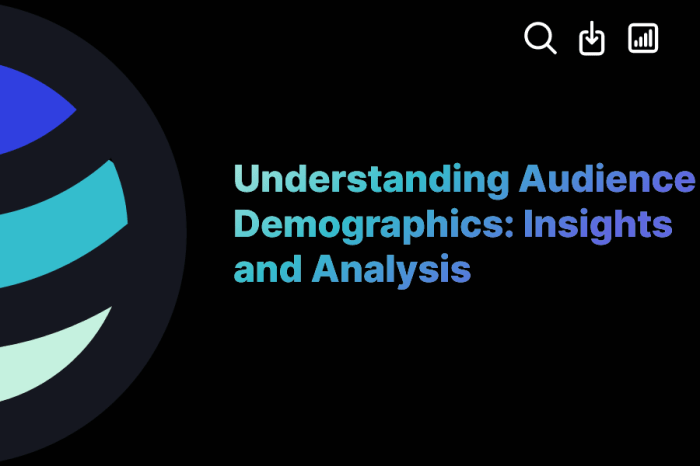Understanding Audience Demographics is like unlocking the secret code to reaching your target market with precision and finesse. Dive into the world of data-driven marketing as we explore the impact of knowing your audience inside and out.
From the importance of demographics to the various types of data collection methods, this topic is a goldmine for businesses looking to boost their marketing strategies.
Importance of Understanding Audience Demographics
Understanding audience demographics is like having the secret sauce for businesses and marketers. It provides valuable insights into who your customers are, what they like, where they are, and how to reach them effectively. Without this crucial information, businesses would be shooting in the dark, wasting time and resources on strategies that may not resonate with their target audience.
Impact on Marketing Strategies
When businesses have a clear picture of their audience demographics, they can tailor their marketing strategies to align with the preferences and behaviors of their target customers. For example, a company targeting young adults may focus more on social media platforms like Instagram and TikTok, while a brand catering to an older demographic might invest in traditional advertising channels like TV commercials or print ads.
- Understanding the age, gender, income level, and interests of your audience can help you create personalized marketing campaigns that speak directly to their needs and desires.
- By analyzing audience demographics, businesses can identify new market segments to expand their customer base and increase revenue.
- Successful companies like Nike and Apple have mastered the art of leveraging audience demographics to create products and services that resonate with their target audience, leading to increased brand loyalty and sales.
Types of Audience Demographics

Understanding audience demographics involves recognizing various factors that play a role in shaping the characteristics of a particular group. These demographics can be categorized into different types such as age, gender, income, education, psychographics, and geographic location.
Age, Gender, Income, and Education
- Age: Different age groups have distinct preferences, behaviors, and consumption patterns. For example, teenagers may be more inclined towards social media platforms, while older adults may prefer traditional media.
- Gender: Gender can also impact interests and choices. Marketers often tailor their messaging based on gender differences to resonate with their target audience.
- Income: Income levels determine purchasing power and buying behavior. High-income individuals may opt for premium products, while those with lower income may look for more affordable options.
- Education: Education level can influence the way people perceive information and make decisions. Highly educated individuals may value quality and innovation in products/services.
Psychographic Factors
- Values: Audience demographics are shaped by personal values and beliefs. Understanding these values helps in creating messaging that aligns with the audience’s core principles.
- Interests: People with similar interests tend to form niche communities. Identifying these interests can aid in targeting specific audience segments effectively.
- Lifestyle Choices: Lifestyle choices encompass activities, hobbies, and habits that individuals engage in. Adapting marketing strategies to match these choices can enhance audience engagement.
Significance of Geographic Location
Geographic location plays a crucial role in audience demographics as it influences cultural norms, climate preferences, and regional trends. Marketers need to consider these factors when tailoring their campaigns to specific locations to ensure relevance and effectiveness.
Collecting Audience Demographic Data: Understanding Audience Demographics
To effectively understand your audience demographics, it is crucial to collect accurate and relevant data. There are various methods available for gathering audience demographic data, including surveys, interviews, social media analytics, and more. Utilizing data analytics tools can also provide valuable insights into audience demographics, helping businesses make informed decisions. Ensuring the accuracy and reliability of collected demographic data is essential for targeting the right audience and tailoring marketing strategies accordingly.
Surveys
Surveys are a common method used to collect audience demographic data. By asking specific questions related to age, gender, location, interests, and more, businesses can gain valuable insights into their target audience. It is important to design surveys carefully to ensure that the data collected is accurate and relevant.
Interviews
Conducting interviews with a sample of your audience can provide in-depth insights into their demographics. Personal interactions can help gather detailed information that may not be captured through other methods. It is essential to structure interviews effectively and ask the right questions to obtain accurate demographic data.
Social Media Analytics
Analyzing data from social media platforms can offer valuable demographic insights. By examining metrics such as age, gender, location, and interests of followers and engagement rates, businesses can better understand their audience. Utilizing social media analytics tools can help in collecting and interpreting this data effectively.
Data Analytics Tools, Understanding Audience Demographics
Using data analytics tools can streamline the process of collecting and analyzing audience demographic data. These tools can provide detailed reports, visualizations, and trends that help businesses make data-driven decisions. It is crucial to choose reliable and accurate data analytics tools to ensure the quality of demographic insights.
Best Practices for Data Accuracy
– Ensure the survey questions are clear and relevant to the audience.
– Use a diverse range of data collection methods to validate the accuracy of demographic data.
– Regularly update and review demographic data to reflect any changes in the audience.
– Cross-reference data from different sources to verify the accuracy of demographic insights.
Utilizing Audience Demographics for Targeted Marketing

Businesses can use audience demographics to create targeted marketing campaigns by tailoring their messages and offerings to specific groups of people based on their characteristics. This allows companies to reach the right audience with the right message, increasing the chances of converting leads into customers.
Role of Personalization in Marketing
Personalization in marketing based on audience demographics involves customizing marketing messages and promotions to suit the preferences, behaviors, and needs of different customer segments. By personalizing content, businesses can create a more meaningful connection with their audience, leading to higher engagement and conversion rates.
Increased Customer Engagement and Loyalty
Understanding audience demographics can lead to increased customer engagement and loyalty by allowing businesses to create targeted marketing campaigns that resonate with their target audience. By delivering relevant and personalized content, companies can build stronger relationships with customers, leading to repeat business and long-term loyalty.












